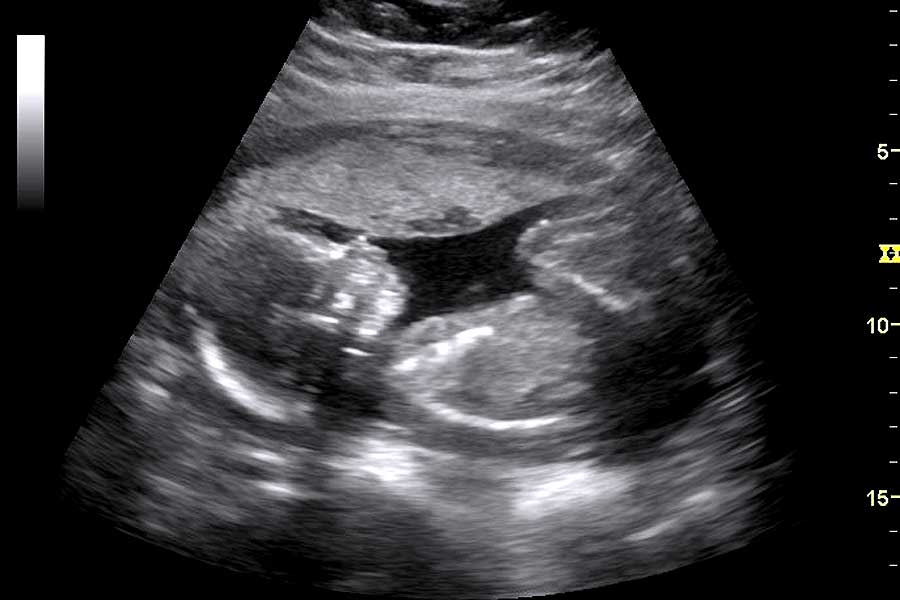
Ultrasound detection of congenital CMV infection
Ultrasound detection of congenital CMV infection
 Tens of thousands of babies are born in the United States with congenital CMV every year. For many of these babies, possible signs of CMV infection were likely visible during pregnancy on ultrasound and, in some cases, additional signs after birth could have pointed to congenital CMV. It is extremely important that signs of congenital CMV be identified and confirmed as early as possible in either the pregnancy period or during the early newborn period, ideally while the newborn is still in the hospital after birth. Early identification of congenital CMV could be the key to possible treatments, interventions, therapies, but also, most importantly, an understanding and diagnosis of a very common virus that could hinder a child's health and development.
Signs of congenital CMV infection during pregnancy
Tens of thousands of babies are born in the United States with congenital CMV every year. For many of these babies, possible signs of CMV infection were likely visible during pregnancy on ultrasound and, in some cases, additional signs after birth could have pointed to congenital CMV. It is extremely important that signs of congenital CMV be identified and confirmed as early as possible in either the pregnancy period or during the early newborn period, ideally while the newborn is still in the hospital after birth. Early identification of congenital CMV could be the key to possible treatments, interventions, therapies, but also, most importantly, an understanding and diagnosis of a very common virus that could hinder a child's health and development.
Signs of congenital CMV infection during pregnancy
If one or more of the following signs are identified via ultrasound, an amniocentesis should be done to confirm a congenital CMV infection:
- Placental thickening
- Organomegaly - abnormal enlargement of organs
- Hepatomegaly – abnormal enlargement of the liver
- Splenomegaly – abnormal enlargement of the spleen
- Pyelectasis - dilation of the renal pelvis, the funnel-like dilated proximal part of the ureter (muscular tubes that propel urine from the kidneys to the urinary bladder) in the kidney (also a marker for Down Syndrome)
- Megaloureter – abnormal dilation of the ureter
- Ascites - gastroenterological term for an accumulation of fluid in the peritoneal cavity (is a potential space between the parietal peritoneum and visceral peritoneum, that is, the two membranes that separate the organs in the abdominal cavity from the abdominal wall)
- Fetal hydrops - accumulation of fluid in the fetal compartments
- Abnormality of amniotic fluid
- Microcephaly – small head circumference, more than two standard deviations smaller than average
- Cerebral ventriculomegaly – dilation of the lateral ventricles of the brain
- Intracranial calcifications - the build up of calcium salts in the soft tissue of the brain
- Hyperdense image in thalamic arteries
- Periventricular echodensities
- Hepatic echodensities
- Intestinal echodensities
- Cystic structures in the germinal zone
Signs of congenital CMV infection in the newborn
A newborn may have congenital CMV if they are showing any of the following signs:
- Thrombocytopenia – low blood platelet levels
- Petechiae (purpura) - Red or purple spots on the body caused by broken blood vessels
- Jaundice - yellow skin and eyes caused by increased bilirubin levels in the blood
- Microcephaly - Small head size
- Small size at birth - IUGR (Intrauterine Growth Restriction)
- Premature birth of unknown etiology
- Liver problems, including Jaundice of unknown etiology
- Spleen problems
- Lung problems
- Bleeding problems
- Growth problems
- Seizures
- Hearing loss
- Vision loss
- Mental disability
(Note: If a newborn does NOT show any of the following signs at birth, it does not mean they cannot be diagnosed with congenital CMV.)
Posted: 8/25/2016
Category: "Basic Facts", Clinical